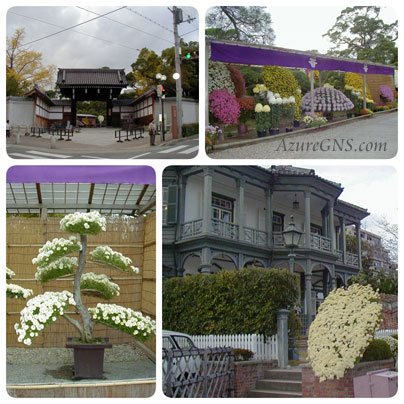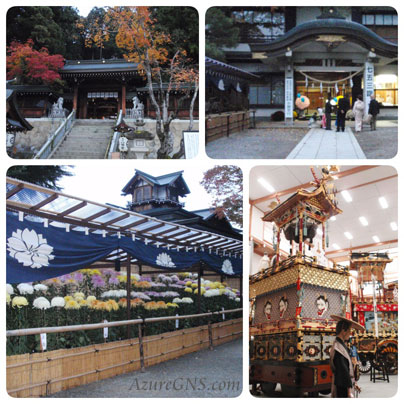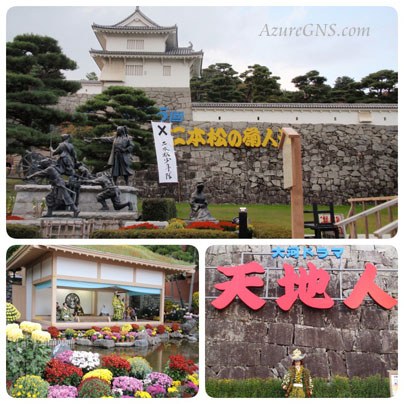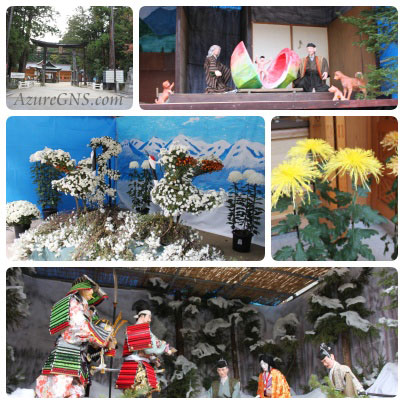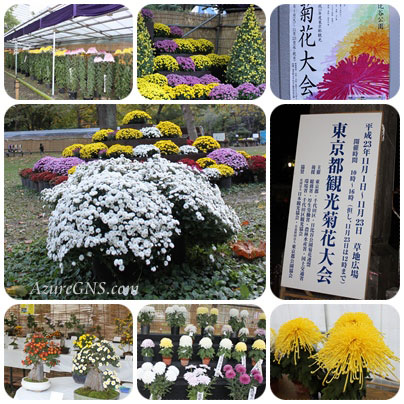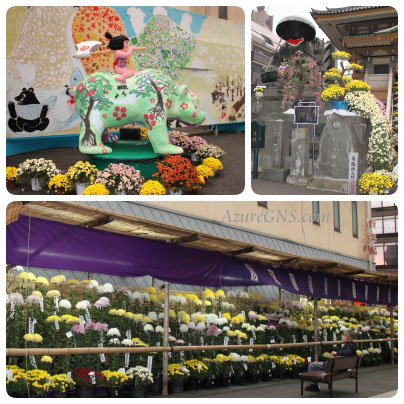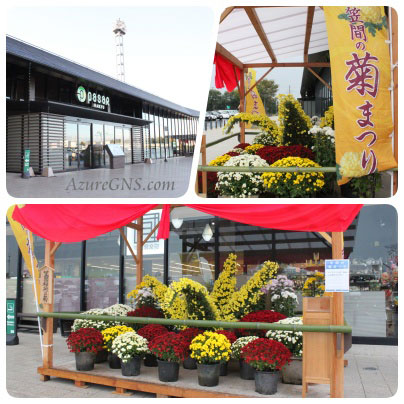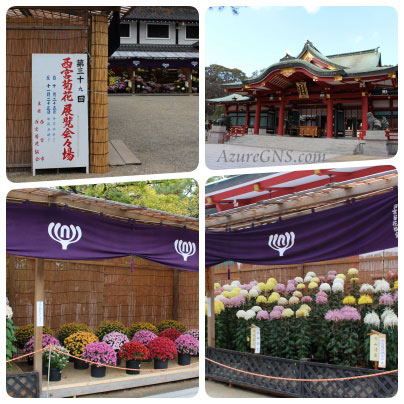Kikka-ten and Kiku-ningyo-ten;
(The Chrysanthemum Exhibitions and the Chrysanthemum Figure Exhibitions)
兵庫県神戸市の実家より歩いて10分ほどの距離にある相楽園は、子供の頃からのたくさんの思い出があります。相楽園は明治維新後、事業に成功した三田藩士の私邸として1911年(明治44年)に完成しました。広大な土地に西洋式の豪華な大邸宅が建てられましたが、神戸大空襲で焼失しました。現在は回遊式日本庭園、茶室、北野町から移築された旧ハッサム邸などがあります。秋にはこちらで、70年近く歴史のある神戸市有数の菊花展が開催されます。春のツツジの時期同様、その時期多くの人で賑わいます。丹精込めて咲かせた約2500鉢の見事な菊が並びます。
I have many good memories from my childhood of Soraku-en Garden, which is approximately a 10-minute walk from my parents’ house in Kobe City, Hyogo Prefecture. Sorakuen Garden was built by a feudal retainer of the Sanda Domain who succeeded in business after the Meiji Restoration, as his private residence in 1911 (Meiji 44th yr). There was a luxurious western style residence on a huge site, but it was burned down during the Kobe Air Raids. At present, there are a Japanese garden in a circular style, a tea house and the former Hassam House relocated from Kitano Town. A chrysanthemum exhibition with a nearly 70-year history is annually held there in autumn and it is one of the best in Kobe City. The garden is crowded with many visitors during the period of the exhibition as well as the azalea season. They enjoy about 2500 pots of beautiful chrysanthemums grown with great care by masters.
菊人形と言えば、子供の頃は大阪府枚方市にあるひらかたパークだけでした。家族で何度も訪れた懐かしい思い出があります。しかしながら、その頃の私は菊よりも同じ敷地内にある遊園地に興味がありました。ひらかたパークは現在も経営している中で最も古い遊園地のひとつです。長期間経営不振の時期もありましたが、企業努力や人気俳優やお笑い芸人のコマーシャルのおかげで、経営状態は少しずつ上向きになっています。1912年(大正元年)に、ひらかたパークで初めて菊人形展が開催されました。戦争や不景気で一時中断しましたが、現在も規模を縮小して開催されています。
Speaking of Kiku-ningyo figures, I remembered only Hirakata Park in Hirakata City, Osaka Prefecture when I was a child. I have happy memories from when I visited it many times with my family. However, I naturally preferred amusement rides to chrysanthemums in those days. Hirakata Park is one of the oldest amusement parks which are still open in Japan. This park fell into financial difficulties for a long time, but nowadays its sales show signs of recovery for the fruits of efforts and advertisements by popular actors and comedians. It was in 1912 (Taisho 1st yr) that the chrysanthemum figure exhibition was held for the first time. Except for several interruptions because of wars or recession, it has been held since then, though its scale is much smaller now.
2008年(平成20年)11月に飛騨高山へ車で出張に行き、仕事の合間にあちらこちで観光しました。高山祭で有名な桜山八幡宮で菊花展が開催されていました。秋の静かな境内には菊の花がよく似合いました。ちょうど七五三の時期で晴着を着た可愛いお子さん達を見かけました。この後、隣接する高山祭屋台会館に行きました。技術の粋を集めた絢爛豪華で巨大な祭屋台を見て圧倒されました。
I took a business trip to Hida-Takayama by car in November 2008 (Heisei 20th yr) and did some sightseeing during my spare time at work. A chrysanthemum exhibition was held at Sakurayama Hachiman-gu Shrine which is popularly known for Takayama Matsuri (Festival). Chrysanthemums matched its quiet precinct. It was a Shichi-go-san festival season so that I saw some cute children dressed in their best clothes. After leaving the shrine, I went to Takayama Matsuri Yatai Kaikan (the Takayama Festival Float Exhibition Hall) next to the shrine. I was overcome by the huge gorgeous festival floats made by skillful and sophisticated artists.
翌日、三重塔と大銀杏で有名な飛騨国分寺へお参りに行きました。高野山真言宗の寺で、757年(天平勝宝9年)頃、行基によって建立されました。その後、何度か焼失や暴風雨で倒壊後、現在も残る三重の塔は1820年(文政3年)に再建されました。ここでも菊花展が開催されていて、菊の良い香りが境内に漂っていました。樹齢1250年以上といわれている大銀杏は、まだほとんど色付いていませんでした。残念ながらこの銀杏は2018年(平成30年)の台風21号で甚大な被害を受けたようです。
The next day, I visited and prayed at Hida Kokubun-ji Temple which is famous for a three-story pagoda and a giant ginkgo tree. It is a Shingon-sect Buddhist temple founded in 757 (Tempyo-shoho 9th yr) by Gyoki (a Japanese Buddhist priest of high virtue). The temple was burned down and destroyed by storms several times. The present three-story pagoda was rebuilt in (Bunsei 3rd yr). The chrysanthemum exhibition was also held at this temple. The scent of chrysanthemums was drifting around the precinct. The leaves of a ginkgo tree older than 1250 years had hardly turned yellow yet. It was a pity that this tree was terribly damaged by the 21st Typhoon in 2018 (Heisei 30th yr).
私の趣味のひとつにお城巡りがあります。特に日本100名城めぐりが好きです。東北を旅行中、福島県二本松市にある100名城のひとつの二本松城を訪れました。60年以上歴史がある二本松菊人形展が偶然開催されていました。テーマはその年の大河ドラマの「天地人」でした。大河ドラマとは日本の公共放送NHKが毎年、一年間放送している日本の歴史を題材にした連続ドラマです。思った以上にドラマの登場人物をリアルに再現してありました。日本最大規模を誇る菊人形展です。
One of my hobbies is visiting castles and I especially like to visit the 100 Fine Castles of Japan. When I travelled the Tohoku District, I visited one of them, Nihonmatsu Castle, in Nihonmatsu City, Fukushima Prefecture. It happened that the Nihonmatsu Chrysanthemum Figure Exhibition which had a longer than 60-year history was being held with the theme of “Tenchijin”, an NHK Taiga Drama for that year. A Taiga Drama is an annual, year-long serial TV drama of Japanese historical fiction broadcast by NHK, Japan’s public broadcaster. The reproduced characters of the drama were more realistic than I had expected. This Chrysanthemum Figure Exhibition in this castle is one of the biggest in Japan.
湯島天満宮(湯島天神)は1500年以上の歴史がある、東京の代表的な天満宮です。東京へ引っ越してから、年に数回訪れています。この神社は学問や受験の神様として知られている菅原道真公を祀っているため、受験期には特に多くの受験生が訪れます。毎年、早春には梅まつり、そして秋には菊まつりが開催されています。湯島天神の菊まつりは、2018年(平成30年)で40回を迎えます。小規模ながら大河ドラマをテーマにした菊人形や、約2000株の色鮮やかな菊が展示されています。
Yushima Temman-gu Shrine (Yushima Tenjin Shrine) is a representative of the Temmangu Shrine in Tokyo. It has a more than a 1500-year history. I have visited this shrine several times a year since I moved to Tokyo. This shrine is dedicated to Sugawara no Michizane, the god of learning and entrance examinations, so the shrine is very crowded with students especially during the entrance examination season. The plum festival is held every early spring, and the chrysanthemum festival every autumn. Kiku-ningyo figures of an NHK Taiga Drama characters and about 2000 colorful chrysanthemums are displayed though its scale is small.
浅草寺は東京で最も古いお寺で、飛鳥時代(529-710)の628年(推古天皇36年)に創建されました。毎年10月には菊供養会(きくくようえ)が開かれ、菊をお供えして、菊のお守りを授与されます。10月中旬から11月中旬まで、菊花展も開催されます。私が訪れた2009年には、二本松からの出展もありました。境内には露店も並び、浅草らしい賑わいを見せていました。
Senso-ji Temple is the oldest temple in Tokyo. It was established in 628 (Empress Suiko 36th yr) of Asuka Period (529-710). Kiku-kuyoe (the Buddhist memorial service with chrysanthemums) is performed every October, and people offer chrysanthemums and are given chrysanthemum charms. The chrysanthemum exhibition is also held from the middle of October to the middle of November every year. I visited it in 2009, and there were the chrysanthemums from Nihonmatsu. The precincts were crowded with people who enjoyed not only the exhibition but also some stalls as usual in Asakusa.
2009年(平成21年)11月に茨城県水戸市にある、日本の三名園の一つの偕楽園を訪れた後、近くにある護国神社に立ち寄りお参りをしました。秋の旅行によくあることですが、ここでも偶然菊花展に出会いました。夕方でしたので、神社内には人影はなく、美しい花々を独り占めすることができました。小菊の華麗な「懸崖作り(けんがいづくり)」を見ると、どれほど多くの手間暇と深い愛情が注がれてきたか推し量ることができます。
After I visited Kairakuen Park, one of the Three Great Gardens of Japan, in Mito City, Ibaraki Prefecture in November 2009 (Heisei 21st yr), I dropped in and prayed at nearby Gokoku Shrine. I happened to see the chrysanthemum exhibition there as was often the case with autumn trips. No other person was seen except for me because I visited the shrine in the evening; therefore, I had the beautiful flowers all to myself. Splendid “Kengai-zukuri”, cascades of little chrysanthemums, showed me how much time, effort and love were devoted to them.
2010年(平成22年)10月に100名城のひとつの長野県小諸市にある小諸城址を訪れました。小諸城は1554年(天文23年)に武田信玄によって築城されました。現在、城址公園には美術館や博物館があり、春は桜の名所としても有名です。私が訪れた時、たまたま菊花展が開催されていました。同時に品評会も開催され、美しさが競われていました。長寿賞の珍しい関取の菊人形や、大臣賞の大輪の菊を見て楽しみました。
In October 2010 (Heisei 22nd yr), I visited Komoro Castle, one of the 100 Fine Castles of Japan, in Komoro City, Nagano Prefecture. Komoro Castle was built by Takeda Shingen in 1554 (Temmon 23rd yr). There are now some museums in the castle park, and it is also famous as a cherry blossom viewing spot in the spring. When I visited the castle, the chrysanthemum exhibition happened to be held. At the same time, beautiful chrysanthemums competed in the competition. I enjoyed seeing a rare Kiku-ningyo figure of a sumo wrestler (traditional national wrestling) which was awarded the longevity prize and big-bloomed chrysanthemums which were awarded the ministers’ prizes.
2011年(平成23年)11月に長野県安曇野市の穂高神社にお参りに行きました。穂高神社は古代にこの地に移住してきた海人族の、安曇氏の祖神を祀った神社です。その安曇氏が安曇野の名前の由来と言われています。穂高神社の境内には菊や丹頂鶴の菊人形がありました。
I went and prayed in Hotaka Shrine in Azumino City, Nagano Prefecture in October 2011 (Heisei 23rd yr). Hotaka Shrine was established to enshrine the patriarchal deity of the Azumi Family from one of the marine clans, who came to this area in ancient times. The name of the Azumi Family is said to be the origin of the Azumino area. When I visited it, I saw chrysanthemums and Kiku-ningyo figures of red-crowned cranes.
東京都千代田区にある日比谷公園内で毎年開催される菊花大会は、1915年(大正4年)に始まり、内閣総理大臣賞をはじめ各大臣賞や都知事賞を受賞した菊も展示されています。巧みの技が作り出した菊の盆栽が出展されています。菊作りの入門講座や、苗の販売が行われています。最近は最盛期に比べて、菊の出展数や観客が少なくなっているのが少し残念に感じます。
The chrysanthemum exhibition at Hibiya Park in Chiyoda, Tokyo has been annually held since 1915 (Taisho 4th yr). Many prize-winning works of chrysanthemums are displayed: the ministers’ prize including the Prime Minister and the Tokyo Governor’s prize. Chrysanthemum bonsai (potted miniature trees) carefully styled with the great skill of artisans are seen there. An introductory lecture of chrysanthemum growing, and a market of young trees are also open. I feel rather sorry that the number of chrysanthemum pots and visitors have lately decreased in comparison with the golden age.
東京都豊島区巣鴨の菊まつりは江戸時代から多くの人で賑わい、浮世絵(伝統的な木版の芸術)や瓦版(17-18世紀の普及した木版の新聞に類似する印刷物)でも取り上げられたようです。諸説ありますが、当時多くの植木職人が住んでいた巣鴨は現在の菊人形の起源と言われています。その流れを受け継ぎ、1993年(平成5年)より「すがも中山道菊まつり」が開催されています。とげぬき地蔵で有名な高岩寺では、菊で飾られた立派な五重塔と三重塔が登場しました。生け花展や、短歌や俳句の展示会、野点、そしてうどん、おでん、お汁粉などの模擬店も開催され、訪問者をもてなしてくれます。
The chrysanthemum festival in Sugamo, Toshima, Tokyo has been crowded with many people since the Edo period, and it was a popular theme of Ukiyoe (traditional wood printing arts) and Kawaraban (wood printing handbills like a newspaper issued around the 17th and 18th centuries). The origin of Kiku-ningyo figures is said to be in Sugamo where a number of gardeners used to live though there are various theories. To inherit this origin, ‘Sugamo Nakasendo Chrysanthemum Festival” started in 1993 (Heisei 5th yr). The five-story and three-story pagodas decorated with chrysanthemums were created in Koganji Temple known as Togenuki-jizo. Various events also entertain visitors: exhibitions of flower arrangements, Tanka and Haiku, open-air tea ceremonies and refreshment stands of udon (thick white noodles made with wheat flour in broth seasoned with soy sauce, sweet sake and salt), oden (various ingredients simmered for a long time in ample broth seasoned with soy sauce and sweet sake), oshiruko (thick sweet soup made from adzuki beans, sugar and a little salt and topped with baked mochi, rice cake) and more.
高岩寺と同時期に、巣鴨地蔵通り商店街の入り口にある眞性寺でも菊まつりが開催されていました。このお寺には江戸六地蔵の第四番が安置され、八代将軍徳川吉宗もたびたびお詣りに訪れました。毎年日本のおとぎ話の世界が描き出される菊形作りですが、この年は足柄山のとても可愛い金太郎さんが題材でした。大人向けの菊まつりの高岩寺に比べて、こちらの菊まつりは、お子さんが喜びそうでした。
At the same time as Kogan-ji Temple, Shinsho-ji Temple at the entrance of the Sugamo Jizo-dori shopping street also held a chrysanthemum exhibition. The fourth jizo (one of the Japanese divinities) statue of Edo Six Jizos is laid in this temple and the eighth Shogun, Tokugawa Yoshimune often visited this temple. Every year Kiku-gata-zukuri (chrysanthemum figures) were made in the motif of Japanese fairy tales, and lovely Ashigarayama-no-Kintaro (a very healthy boy with superhuman powers in Mt. Ashigara, who was promoted when growing up) was made that year. Chrysanthemum figures at Kogan-ji Temple were for adults, while those in Shinsho-ji Temple were for children.
2013年(平成25年)11月に足利へ仕事のために車で行った帰り、羽生パーキングエリア上り線で休憩しました。そこで、かねてより見たいと思っていた「笠間の菊まつり」を紹介する旗と素晴らしい菊を見つけました。以前より笠間の菊まつりを見たいと思っていました。パーキングエリアから開催地まで100 km近く、車で1時間以上かかりますが、予定を変更して見に行くことにしました。
I stopped by Hanyu Parking Area on the inbound lane of the highway for a rest on my way home from a business trip to Ashikaga City by car in November 2013 (Heisei 25th yr). I found a flag and gorgeous chrysanthemums to advertise “Kasama Chrysanthemum Festival” which I had long wanted to see. I changed my plan and decided to go and see it though it was nearly 100 km away, more than an hour by car from the parking area to the venue.
笠間の菊まつりは、伏見稲荷神社、豊川稲荷神社と並んで日本三大稲荷(諸説あります)と称される笠間稲荷神社で開催されていました。この菊まつりは先々代の宮司が、日露戦争後で落ち込みすさんだ人々の心を和ませるため1908年(明治41年)に始まりました。約1万鉢の美しい菊の花が境内だけでなく市内を彩りました。その年の大河ドラマの「八重の桜」の菊人形も楽しみました。
The Kasama Chrysanthemum Festival was held in the Kasama Inari Shrine which is regarded as one of the three major Inari shrines in Japan along with the Fushimi Inari Shrine and the Toyokawa Inari Shrine (another theory exists). The Guji (chief priest) before the last started this chrysanthemum festival in 1908 (Meiji 41st yr) to make people, who had become depressed and unsettled, feel at ease after the Russo-Japanese War. About 10,000 pots of beautiful chrysanthemums add vivid colors to the precinct as well as the whole city. I also enjoyed Kiku-ningyo figures with the motif of “Yae no Sakura”, the NHK Taiga Drama for that year.
日本の秋に咲く花々の中で、菊より煌びやか(きらびやか)に咲く花はあるでしょうか。西宮神社の境内では秋を彩る「西宮菊花展覧会」が毎年開催されます。西宮菊花協会の会員の皆様が、1年間手塩にかけて育てた美しい菊が展示されています。商売の神様として広く信仰されて西宮神社は、日本に約3500社あるえびす神社の総本山です。毎年1月に行われる「十日えびす」で有名です。こちらの英語のパンフレットを弊社で作らせて頂きました。
Among autumn flowers in Japan, what could be more gorgeous than chrysanthemums? “Nishinomiya Chrysanthemum Exhibition” adorns the autumn of the precinct of Nishinomiya Shrine every year. There are Chrysanthemums which members of the Nishinomiya Chrysanthemum Association raise with special care for 1 year. Nishinomiya Shrine, which has been widely adored as the god of business prosperity, is the headquarters of the Ebisu sect including 3500 shrines. This shrine is famous for an annual festival, “Toka Ebisu” held in January. We were very fortunate that we were asked to make its English brochure.
(「菊の節句(重用)」に戻ります。)
(Back to “The Chrysanthemum Festival”.)
Copyright (C) Azure Global Network Services. All Rights Reserved.
